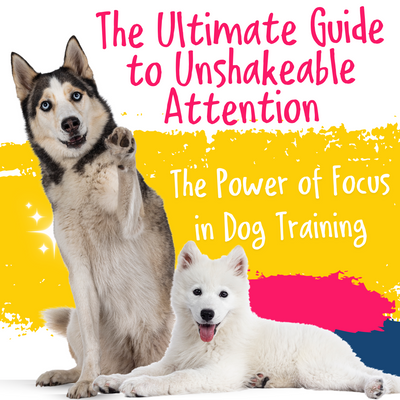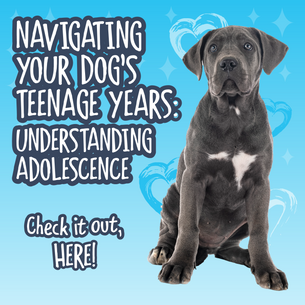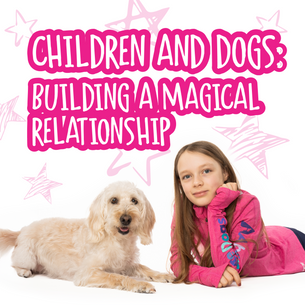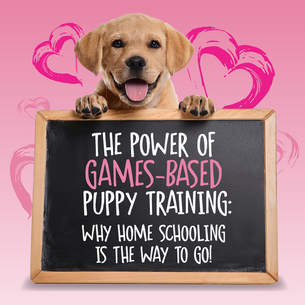The Power of Focus in Dog Training
In the heart of every distracted dog is a focused dog waiting to shine. Whether it's a squirrel, an intriguing scent, or another dog, distractions are a natural part of the canine world. Yet, understanding and harnessing this aspect of your dog's behaviour is the secret to unlocking an extraordinary training experience. This guide is the start of your roadmap to achieving unshakeable attention from your dog, ensuring distractions become opportunities for bonding and learning.
But first, here is your special download and game card to get you started on an incredible game that will empower you and take your distraction training to the next level.

Understanding Dog Psychology

The Why Behind Chase and Predatory Drive
Dogs are inherently curious and responsive to their environment. This section delves into the evolutionary reasons behind your dog's distractibility and how these instincts can enhance training when properly managed.
At first glance, your dog's chase after a squirrel might seem like a simple act of play or mischief. However, this behaviour is rooted in their ancestral DNA, a vivid echo of their past. Dogs, descendants of wolves, retain many of their ancestors' traits, including the instinctual drive to hunt. This predatory drive is not just about the pursuit of prey but is a complex behaviour that encompasses tracking, stalking, and capturing. Understanding this natural impulse is the first step in appreciating why distractions like these are so compelling to our canine companions. It opens up a window to empathize with their needs and behaviours, setting the stage for more effective and respectful training methods that align with their natural inclinations, channelling their natural drives so that you can incorporate them into your training sessions for optimal real-life results and behaviour transformation.
Predatory Drive
The predatory drive in dogs is a fascinating aspect of their behaviour, showcasing a sequence of behaviours that were essential for survival in the wild. This drive is a sequence of behaviours that starts with the dog noticing a potential 'prey,' then stalking it, chasing it, grabbing it, and finally killing it. In domestic dogs, these behaviours are often seen in play and their interactions with toys, other animals, and sometimes, unfortunately, with moving vehicles or joggers. This drive is not a sign of aggression in your dog but rather a natural activity. Recognising and managing this drive is crucial in training and everyday interactions. By channelling this energy into positive and safe outlets, such as structured play and training exercises, dog owners can significantly improve focus and reduce unwanted behaviors. Properly engaged, the predatory drive can enhance your dog's training, providing them with the necessary stimulation and satisfaction that comes from fulfilling these instinctual urges.
The Predatory Sequence & How It Can Vary Due To Your Dog's Genetic Makeup
The concept of the predatory sequence, or motor pattern, in dogs is varies significantly across breeds, influenced by their historical roles and breeding purposes. This sequence—spotting/seeing/orienting, stalking, chasing, grabbing, and ultimately, the bite—represents a pattern of behaviour that has been selectively honed over centuries. For instance, herding dogs like Border Collies may excel in the stalking and chasing aspects, bred to control the movement of sheep without harming them, which demonstrates a modification of the sequence where the final stages are suppressed.
On the other hand, terriers, bred for hunting and killing vermin, often display the full sequence, showcasing their effectiveness in quickly dispatching prey. Understanding the nuances of the predatory sequence in your dog's breed can provide invaluable insights into their behaviour, preferences, and sometimes, their training needs. Recognizing and respecting these inherent tendencies allows for a more tailored and effective training approach, enabling owners to channel their dogs' instincts into behaviours that are both fulfilling for the dog and appropriate for their lifestyle. This is where games-based training can be a powerful and tailored approach that takes into consideration the entire dog and never defaults to a cookie-cutter approach.
What is the right reward for your dog?
Gain insights into the canine sensory experience, including how dogs perceive their surroundings differently than humans with their different senses. This knowledge is crucial for creating training scenarios that captivate their attention and will put you on a higher level than any distraction.
Sight: Dogs use their sight daily to navigate their world, identify friends and potential threats, and engage in play. Integrating sight into their reward strategy could involve using visually stimulating toys or movements to capture their attention and praise for desired behaviours. For example, after your dog successfully ignores a distraction like a passing car, reward them with a favourite colourful toy that grabs their visual interest, reinforcing their positive behaviour and providing them with an action-based experience that relieves the frustration they may experience by not participating in the chase/grab/bite sequence their innate drives are encouraging them to experience.
Hearing: Dogs rely on their hearing to interpret verbal commands from their owners, detect danger, and communicate with other dogs. To incorporate hearing into rewards, use a cheerful, enthusiastic tone of voice when praising them or offer verbal cues that lead to enjoyable activities, such as a walk, playtime, the cue to go run and chase and disengage. Following a cue well-executed, a happy and high-pitched "good boy/girl!" can serve as an immediate auditory reward, reinforcing the behaviour and increasing the likelihood it will happen again.
Smell: A dog's sense of smell is incredibly powerful, used for exploring their environment, recognising individuals, and even detecting emotions. Allowing your dog to engage in sniffing as a reward leverages this sense effectively. After performing a difficult task, such as staying calm when another dog is barking aggressively, let them explore a scent-rich area or offer a treat with a strong, appealing smell to sniff out and enjoy.
Taste: Taste is closely linked with smell and is a significant factor in a dog's enjoyment of food and treats. You can use their taste preference as a reward by offering a small piece of a highly favoured treat, such as cooked chicken or fish, after challenging behaviour like ignoring a darting rabbit. This rewards your dog and also creates a positive association with following your cues despite strong temptations. This is a massive win!
Touch: Some dogs find physical affection reassuring and enjoyable, using touch to strengthen their bond with their owners. Incorporate touch into your reward strategy by providing a soothing massage or gentle petting in their favourite spots after they complete a task, like coming to you instead of chasing after a squirrel. This not only rewards them and enhances your physical connection, reinforcing their trust and cooperation. It's important to note that many dogs are not as apt to respond only to touch as a reinforcement strategy, even if they enjoy touch overall. Touch can also be too stimulating and create a lack of focus if your dog responds with an increase in arousal vs. finding the touch comforting or solely as valuable information that communicates a job well done.
By tapping into your dog's motor patterns and understanding what your dog finds rewarding, you can unlock an incredible level of focus from your dog - and ultimately, that focus will power up your training.
We have so much more we want to share with you and we will share more REAL LIVE dog training and games in our Sexier than a Squirrel LIVE event. Everything above will help to give you a foundation of awareness as to how you can achieve ultimate levels of focus and attention from your dog... Our event will dive into practical games and solutions that you can apply right away AND will give you the next steps to make your dog-owning reality a dream come true.

Preparation for Sexier than a Squirrel LIVE
To maximise the value of the upcoming live event, this section provides exclusive tips and exercises to prepare you and your dog. Engaging with this content ahead of the event will enhance your live experience, allowing you to apply the lessons in real-time.
EVENT PREP
Here's how you can get ready for the "Sexier than a Squirrel LIVE" event from a technological and environmental standpoint:
Tech Setup Check
- Ensure your internet connection is stable to avoid disruptions during the live stream.
- Test the device (laptop, tablet, smart TV) you'll use to watch the event for audio and video clarity.
- Watch your inbox for event information so you can familiarise yourself with the platform for the video stream (YouTube, Facebook, etc.).
Review Early Bird Bonus
- Download and review the DMT bonus linked above.
- Identify key techniques or questions you might have to look out for answers during the event.
Prepare Your Environment
- Choose a quiet, comfortable room where you and your dog can watch and participate in the event without distractions.
- Arrange your space with enough room to practice training exercises and play games introduced during the event.
- Have your dog’s favourite treats and toys within reach to use during interactive segments.
- Consider setting up a "training station" with a water bowl, a comfy mat for your dog to sit on, and any training tools you might need (clicker, leash).
It's Time for the Event!
- Give your dog a good walk or some exercise before the event starts to help them settle down and focus.
- Plan short breaks during the event to let your dog relax and process the activities.
- Keep a notepad or device handy to jot down tips, ideas, or questions that come up during the stream.
By preparing your technology and environment, you'll ensure that you and your dog can fully engage with the "Sexier than a Squirrel LIVE" event, making the most of the live demonstrations and interactive games. This proactive approach guarantees an enjoyable and enriching experience, filled with learning and fun.
The Dog Training Journey Ahead
As you apply the insights and strategies from the resource download, remember that training is a journey, not a destination. Celebrate each milestone, learn from every challenge, and cherish the moments of connection that deepen your bond with your dog. The path to unshakeable attention is paved with patience, understanding, and a shared sense of adventure. Let this guide be your companion as you and your dog embark on this transformative journey together. Keep an eye on your email inbox for more information about how to access the learning (and we'll send you extra goodies along the way, too, jam-packed with supercharged tips and strategies!).




